Standing Royal Navy deployments
 |
| Her Majesty's Naval Service of the British Armed Forces |
|---|
| Components |
|
|
| History and future |
|
|
| Ships |
| Personnel |
| Auxiliary services |
Standing Royal Navy deployments is a list of operations and commitments undertaken by the United Kingdom's Royal Navy on a worldwide basis.[1] The following list details these commitments and deployments sorted by region and in alphabetical order. Routine deployments made by the Navy's nuclear-powered submarines and their location of operations is classified.
Atlantic
Antarctic Patrol
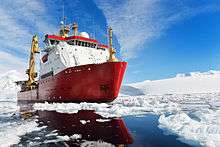
Antarctic Patrol is undertaken by the Royal Navy's Icebreaker and survey ship, HMS Protector, in the South Atlantic Ocean. Its primary mission is "surveying and gathering data on the seas around Antarctica" while also providing support to the British Antarctic Survey operation stationed in and around the British Antarctic Territory.[2] Two Royal Research Ships of the Merchant Navy are also stationed in the region; RRS James Clark Ross and RRS Ernest Shackleton.
Atlantic Patrol Tasking North
Formerly known as the West Indies Guard Ship.[3] This is the Royal Navy's commitment to secure and protect the interests of the United Kingdom and British Overseas Territories in the regions of the North Atlantic and the Caribbean. The deployment primarily conducts counter narcotics missions and provides humanitarian assistance during hurricane season.[4]
This tasking was augmented by Operation Ruman in 2017 as a result of damage caused by Hurricane Irma.[5]
The task is typically carried out by a single warship, or more recently by a River class patrol vessel or a Royal Fleet Auxiliary vessel.[6] As of April 2018, the RFA Mounts Bay (L3008) is assigned.[7]
Atlantic Patrol Tasking South
The Royal Navy maintains a permanent presence in the South Atlantic and West Africa to provide "ongoing protection and reassurance to British interests" such as the sovereignty of the Falkland Islands and South Georgia, while also supporting British Forces South Atlantic Islands. The commitment consists of two warships; either a guided-missile destroyer or frigate accompanied by a Royal Fleet Auxiliary vessel.[8]
Falkland Islands Patrol Task
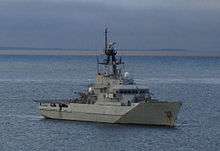
The Falkland Islands Patrol Task consists of a single warship (an Offshore Patrol Vessel) stationed around the EEZ of the Falkland Islands. It forms part of British Forces South Atlantic Islands and aims to reassure the inhabitants of the region and maintain British sovereignty.
HMS Clyde has been permanently assigned to the task since her commission.[9] Clyde uses the deepwater naval base facilities of East Cove Military Port at Mare Harbour, East Falkland.
Standing NATO Maritime Group 1
The Standing NATO Maritime Group 1 is part of the wider NATO Response Force, its standard area of operations is the Atlantic Ocean.[10] As of January 2016, the type 23 frigate HMS Iron Duke was the latest British contribution to the task force.[11]
British and Northern European Waters
Cold Weather Training
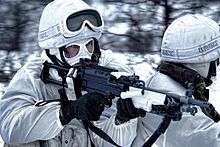
Cold Weather Training is a Royal Navy commitment to the annual Norwegian-led exercise in the Arctic regions. Its purpose is to build and strengthen military ties and to enable the Royal Marines and Royal Navy sailors to "fight and win" in extreme conditions.[12]
Faslane Patrol Boat Squadron
The Faslane Patrol Boat Squadron (FPBS) provides force protection in around the waters of HMNB Clyde, where the Royal Navy's nuclear-powered submarine fleet is based. The squadron currently consists of HMS Tracker and HMS Raider.[13]
Fishery Protection
The Fishery Protection Squadron is charged with protecting the British fishing industry, providing security to the oil and gas fields in the North Sea and other duties in the United Kingdoms Exclusive economic zone. It consists of one warship; the offshore patrol vessel HMS Mersey.[14]
Fleet Ready Escort
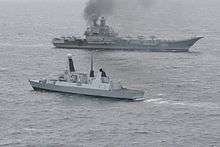
The Fleet Ready Escort (FRE) is a single warship maintained at high readiness for deployment at short notice anywhere in the world. The FRE consists of either a guided-missile destroyer or a frigate.[1] As of January 2014, this commitment has been 'gapped' by the Royal Navy twice; for 19 days in 2011 and 18 days in 2012.[15]
Flag Officer Sea Training
Training in UK Home Waters is essential for preparing both crews and ships before overseas deployment. Flag Officer Sea Training (FOST) is responsible for making sure that both Royal Navy and Royal Fleet Auxiliary ships are fit for operational propose after rigorous exercises and readiness inspections. This commitment is ongoing 365 days a year.[16]
As of May 2018 RFA Tidespring (A136) is assigned to FOST.
Joint Warrior
Exercise Joint Warrior is a Royal Navy (and wider British Armed Forces) commitment to engage in an biannual tri-service exercise (including multinational NATO forces) intended to achieve enhanced military effect. It is the largest military exercise in Europe.[17]
Towed Array Patrol Ship
Towed Array Patrol Ship (TAPS) is a standing task for reactive anti-submarine patrol duties in support of the Continuous At Sea Deterrent (Trident).[18] A Type 23 frigate is maintained at high readiness for this task 365 days a year.[19]
East of Suez
This is a list of operations and commitments presently undertaken by the Royal Navy East of Suez in the Red Sea, Gulf of Aden, Persian Gulf, Arabian Sea, the wider Indian Ocean and the Far East:
Combined Task Force
The Royal Navy regularly contributes to two multinational coalitions; Combined Task Force 150 and Combined Task Force 151. Combined Task Force 150 is focused on maritime security and counter-terrorism; while Combined Task Force 151 is charged with anti-piracy missions.[20]
Humanitarian Missions
The Royal Navy remains committed to providing humanitarian aid where possible. During the 2004 Indian Ocean earthquake and tsunami the Royal Navy responded by deploying RFA Diligence and the frigate HMS Chatham with Westland Lynx helicopters to provide assistance.[21] In 2014, the Royal Navy deployed HMS Echo (a multi-role hydrographic survey ship) and HMS Tireless (a nuclear-powered fleet submarine) to search for the missing Malaysia Airlines Flight 370 in the Indian Ocean Region.[22]
Operation Atalanta
Operation Atalanta is a European Union multinational task force charged to combat terrorism and piracy off the Horn of Africa and Somalia. Operational headquarters are located in the United Kingdom at Northwood Headquarters, London.[23] British ships in the region are usually assigned to CTF.
In November 2017 Charles Stickland (Major General of the Royal Marines) was appointed as CO of Operation Atlanta.[24]
Operation Kipion
Operation Kipion is an ongoing maritime presence in the Gulf and Indian Ocean by the Royal Navy to protect and secure the nation's many political and commercial interests. The enduring commitment usually consists of an escort (a guided-missile destroyer or frigate), a supporting Royal Fleet Auxiliary ship and several other ships with various roles.[25] Operation Kipion was formerly known as the Armilla patrol during the 1980s and 1990s.
Operation Kipion Mine Countermeasures
The Royal Navy maintains a permanent presence in the Gulf consisting of mine countermeasure vessels. It provides continued support to the region ensuring the "safe flow of trade and oil".[26] Typically the mine countermeasure vessels are supported by a Royal Fleet Auxiliary ship acting as a 'mothership'.
Global
Continuous At Sea Deterrent

The Continuous At Sea Deterrent (CASD) (or Trident) is provided by the Royal Navy's four Vanguard-class submarines which deploy on a continuous basis around the globe. The Vanguard-class are each armed with a maximum of 16 Trident II D-5 submarine-launched ballistic missiles and 48 nuclear warheads.[27]
International Partnerships
The Royal Navy remains committed to working with its International Partners around the globe. The principal purpose of these partnerships is to reassure allied nations, to share intelligence and expertise, to build trust and ultimately provide security across the worlds oceans.[28] Examples of such International Partnerships of which the Royal Navy plays a leading role include; the maritime component of the Anglo-French Combined Joint Expeditionary Force (CJEF), the North Atlantic Treaty Organization, AUSCANNZUKUS, the European Maritime Force and the Five Power Defence Arrangements. The United Kingdom is a member of RIMPAC also, although it hasn't participated in way of deploying a surface ship in several years.
Joint Expeditionary Force (Maritime)
_MOD_45162223.jpg)
Joint Expeditionary Force (Maritime) (JEF(M)) -formerly the Response Force Task Group (RFTG) created under the 2010 Strategic Defence and Security Review- is the Royal Navy's amphibious expeditionary task group maintained at high-readiness and available at short notice to respond to unexpected global events. In addition to amphibious operations, the JEF(M) can undertake a diverse range of activities such as evacuation operations, disaster relief or humanitarian aid.[29] The composition of the JEF(M) generally consists of several large amphibious warfare ships (both RN and RFA) and replenishment ships from the Royal Fleet Auxiliary.
To demonstrate the operational readiness and global reach of the JEF(M), the Royal Navy deploys the amphibious task group on annual large scale international exercises, primarily in the Mediterranean and Indian Ocean.[30][31] As an international deployment, the JEF(M) gets the chance to engage in "intense" exercises with foreign and allied navies, such as (for example) the Royal Navy of Oman.[32]
NATO Mine Countermeasures
This is the Royal Navy's commitment to support NATO MCM operations in the Baltic, Northern European Waters, the Atlantic and the Mediterranean Sea (though it is capable of deploying globally if needed). There are two organisational structures; Standing NATO Mine Countermeasures Group 1 and Standing NATO Mine Countermeasures Group 2.[33]
Mediterranean
Gibraltar Squadron
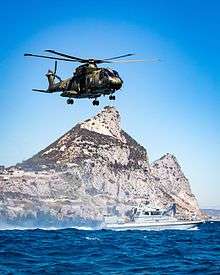
The Gibraltar Squadron consists of two fast patrol boats; HMS Scimitar and HMS Sabre. They provide force protection for NATO or coalition warships entering the naval facilities of Gibraltar and conduct maritime security in the surrounding British territorial waters.[34]
Standing NATO Maritime Group 2
The Royal Navy routinely provides a single warship to the Standing NATO Maritime Group 2 (part of the NATO Response Force). The standard area of operations for the Standing NRF Maritime Group 2 is the Mediterranean Sea.[10]. In 2017, HMS Duncan deployed as flagship of the group, HM Ships Diamond and Ocean also took on the role prior to Duncan resuming her duties in early 2018 till July 2018.[35]
Special Purpose Task Group
In April 2016, IHS Jane's reported that the Royal Navy had formed a new marine task group, named the Special Purpose Task Group (SPTG), in December 2015. The task group is reportedly 150-strong and centred around Zulu Company of 45 Commando Royal Marines. It conducts counter-trafficking, counter-terrorism operations as well as providing support to United Kingdom Special Forces. The SPTG's first operational deployment was in January 2016 to the Mediterranean on board RFA Mounts Bay (L3008). Additional personnel from 29 Regiment Royal Artillery, 17 Port and Maritime Regiment of the Royal Logistic Corps, 24 Engineer Regiment, and 30 (Information Exploitation) Commando Royal Marines were attached to provide specialist capabilities and expertise.[36]
Pacific
Humanitarian Missions
Although the Royal Navy no-longer maintains a permanent naval presence in the Pacific Ocean, it is always committed to providing humanitarian aid where possible. When Typhoon Haiyan struck the Philippines in late 2013, the Royal Navy deployed HMS Daring and HMS Illustrious as part of the United Kingdom's humanitarian aid mission to the region (known as Operation Patwin).[37]
Other
As of late 2014, warships deployed on the Atlantic Patrol Tasking South have routinely extended their operations into the South Pacific. The latest warship to be deployed is HMS Lancaster, departing the United Kingdom on 21 March 2015 for a 9-month deployment to the region.[38] Lancaster relieved HMS Dragon which had been deployed since October 2014.[39] In April 2016, the Royal Navy successfully attained Observer membership of the Western Pacific Naval Symposium (WPNS).[40]
See also
References
- 1 2 "The Royal Navy Deployed Forward Operating Globally" (PDF). Royal Navy. Retrieved 21 May 2014.
- ↑ Antarctic Patrol, royalnavy.mod.uk, Retrieved 1 June 2014
- ↑ "West Indies Guard Ship". Retrieved 5 September 2008.
- ↑ Atlantic Patrol Tasking North, royalnavy.mod.uk, Retrieved 1 June 2014
- ↑ "Operation Ruman". www.royalnavy.mod.uk. Retrieved 2018-06-01.
- ↑ Tony Skinner, 'RN cuts back Standing Task commitments,' Jane's Defence Weekly, 20 July 2005, p.12
- ↑ Navy News. April 2018. Missing or empty
|title=(help) - ↑ Atlantic Patrol Tasking South, royalnavy.mod.uk, Retrieved 1 June 2014
- ↑ Falkland Islands Patrol Task, royalnavy.mod.uk, Retrieved 1 June 2014
- 1 2 Standing NATO Maritime Group 1 and 2, aco.nato.int, Retrieved 2 June 2014
- ↑ HMS Iron Duke deploys, royalnavy.mod.uk, January 2016
- ↑ Cold Weather Training, royalnavy.mod.uk, Retrieved 2 February 2015
- ↑ "Faslane Patrol Boat Squadron". royalnavy.mod.uk. Retrieved 26 August 2017.
- ↑ Fishery Protection
- ↑ House of Commons Hansard Written Answers (publications.parliament.uk) 27 January 2014
- ↑ Training, royalnavy.mod.uk, Retrieved 2 June 2014
- ↑ Joint Warrior, royalnavy.mod.uk, Retrieved 2 June 2014
- ↑ Ministry of Defence. "Freedom of Information response to Mr A J Howell" (pdf). whatdotheyknow.com.
- ↑ "House of Commons Written Answers c121W". UK Parliament. 28 March 2011.
- ↑ CTF 150, royalnavy.mod.uk, Retrieved 2 June 2014
- ↑ UK boosts help for tsunami victims, theguardian.com, 31 December 2004
- ↑ Search For MH370, royalnavy.mod.uk, Retrieved 2 June 2014
- ↑ Spanish Ambassador Visits Operational Headquarters in the United Kingdom, eunavfor.eu, 28 May 2014
- ↑ "Chain of command | Eunavfor". eunavfor.eu. Retrieved 2018-05-10.
- ↑ Operation Kipion, royalnavy.mod.uk, Retrieved 2 June 2014
- ↑ Operation Kipion Mine Countermeasures, royalnavy.mod.uk, Retrieved 27 April 2014
- ↑ Continuous At Sea Deterrent, royalnavy.mod.uk, Retrieved 2 June 2014
- ↑ International Partnerships, royalnavy.mod.uk, Retrieved 2 June 2014
- ↑ Royal Navy ready for unforeseen global events, gov.uk, 9 May 2011
- ↑ Royal Navy sails for annual ‘Cougar’ deployment, royalnavy.mod.uk, 09 August 2013
- ↑ Royal Navy set for Cougar 13, gov.uk, 08 August 2013
- ↑ Royal Navy sharpens claws for Exercise Omani Cougar, royalnavy.mod.uk, 25 October 2013
- ↑ NATO Mine Countermeasures, royalnavy.mod.uk, Retrieved 2 June 2014
- ↑ Gibraltar Squadron, royalnavy.mod.uk, Retrieved 2 June 2014
- ↑ https://www.royalnavy.mod.uk/news-and-latest-activity/news/2018/february/06/180206-hms-albion-deploys
- ↑ "UK forms new marine task group". IHS Jane's. 14 April 2016.
- ↑ Operation Patwin, royalnavy.mod.uk, Retrieved 2014
- ↑ HMS Lancaster deploys, royalnavy.mod.uk, Retrieved March 2015
- ↑ HMS Dragon leaves Portsmouth on deployment, royalnavy.mod.uk,Retrieved 2015
- ↑ Royal Navy joins partners in Asia-Pacific region, royalnavy.mod.uk, 15/04/2016
External links
- Royal Navy: Operations (royalnavy.mod.uk)